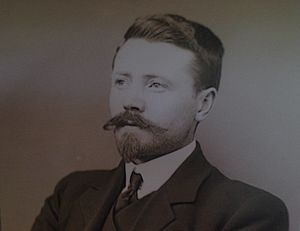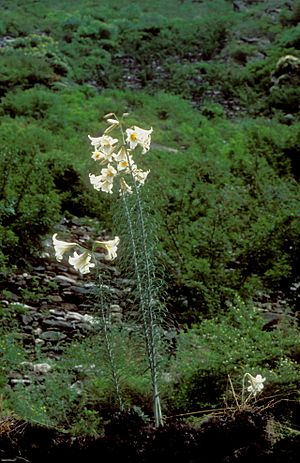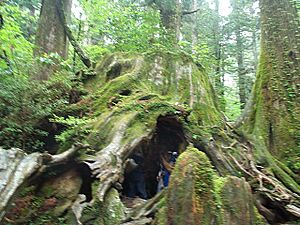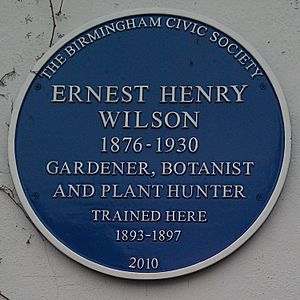Ernest Henry Wilson facts for kids
Quick facts for kids
Ernest Henry Wilson
|
|
|---|---|
 |
|
| Born | 15 February 1876 Chipping Campden, Gloucestershire, England
|
| Died | 15 October 1930 (aged 54) |
| Nationality | British |
| Other names | "Chinese" Wilson |
| Education | Birmingham Municipal Technical School |
| Occupation | Plant collector |
| Awards | Veitch Memorial Medal (1906) |
Ernest Henry Wilson, often called "Chinese" Wilson, was a famous British plant collector and explorer. He lived from 1876 to 1930. Wilson brought about 2000 new plant species from Asia to the Western world. Many of these plants are still popular today. About sixty plants are even named after him!
Contents
Becoming a Plant Explorer
Wilson was born in Chipping Campden, England. His family later moved to Shirley, where they started a flower business. Ernest loved plants from a young age.
Early Training and Studies
He left school early to work as a gardener. First, he was an apprentice at a local nursery. Then, at 16, he worked at the Birmingham Botanical Gardens. He also studied botany at night school. He even won a special award called the Queen's Prize for his botany skills.
Working at Kew Gardens
In 1897, Wilson started working at the Royal Botanic Gardens, Kew. This is a very famous garden in England. He won another award there for an essay about conifer trees. Soon, a plant company called James Veitch & Sons hired him. They wanted him to find a special "dove tree" in China.
Adventures in China
Wilson's first big trip was to China. He traveled across the United States by train. Then he sailed to Hong Kong, arriving in June 1899.
Searching for the Dove Tree
He was told to find a unique dove tree that someone had seen years before. When he got there, the tree had been cut down. But Wilson didn't give up! He found more dove trees about 600 kilometers away. These were the same kind of trees that another explorer, Père David, had noticed earlier.
Collecting New Plants
Wilson spent two years exploring Hubei Province in China. He went into remote mountain valleys. His brave spirit made him a legend. He returned to England in 1902 with seeds from 305 different plant types. He also brought 35 special boxes filled with bulbs and roots. Many of these plants were new to the Western world.
Discovering the Regal Lily
After his first trip, Wilson married Helen Ganderton. But he was soon sent back to China. This time, his goal was to find a yellow Chinese poppy. In 1903, he discovered the amazing Regal Lily in western Sichuan. He went back to this spot in 1908 to collect more lily bulbs.
A Difficult Journey
In 1910, Wilson returned to the Min River valley again. While being carried in a sedan chair, his leg was crushed by falling rocks during an avalanche. He bravely used his camera tripod to set his broken leg. Then, he was carried for three days to get help. After that, he always walked with what he called his "lily limp." This third shipment of lily bulbs successfully brought the Regal Lily to gardens in the United States.
Plants Wilson Introduced
Wilson introduced many plants to Western gardens. Some famous ones from his first trip include the Paperbark Maple, Kiwifruit, and different types of Clematis. He also claimed to have brought 25 kinds of wild roses to the West. One rose, Rosa willmottiae, was named after Ellen Willmott, a famous garden expert.
Later Expeditions and Work
Wilson continued his plant hunting adventures. He became a collector for the Arnold Arboretum in Boston.
Journeys to Japan and Beyond
He made more trips to China in 1907, 1908, and 1910. From 1911 to 1916, he explored Japan. There, he collected 63 different types of cherry blossoms. He also introduced Western readers to the giant "Wilson stump" in Yakushima, Japan. This tree stump is from a tree that was over 3,000 years old when it was cut down centuries ago!
Becoming a Director
In 1917–1918, Wilson explored Korea and Taiwan. When he returned to the Arnold Arboretum in 1919, he became an Associate Director. A few years later, he went on a two-year trip around the world. He visited Australia, New Zealand, India, Central and South America, and East Africa. In 1927, he became the Keeper of the Arnold Arboretum.
Ernest Wilson and his wife sadly died in a car accident in Massachusetts in 1930.
Awards and Recognition
Wilson received many honors for his important work in horticulture (the art of garden cultivation).
Special Medals and Degrees
He received the Veitch Memorial Medal in 1906 and the Victoria Medal of Honour in 1912. Both are from the Royal Horticultural Society. He also got honorary degrees from Harvard University and Trinity College.
Plants Named After Him
More than 100 plants that Wilson introduced have received special awards. Sixty different plant species and varieties are named after him! A book called Plantae Wilsonianae even listed some of the plants he introduced.
Memorials
There is an Ernest Wilson Memorial Garden in his hometown of Chipping Campden. A blue plaque marks his birthplace there. In 2010, another blue plaque was placed at the Birmingham Botanical Gardens to remember his time working there.
For a flower show in 2015, gardeners created an exhibit called "China 'Mother of Gardens'." They used many of the plant species that Wilson discovered.
Selected Works
- Vegetation in western China: a series of 500 photographs with index (1912)
- Naturalist in western China, with vasculum, camera, and gun (1913)
- Conifers and taxads of Japan (1916)
- The cherries of Japan (1916)
- Aristocrats of the garden (1917)
- Romance of our trees (1920)
- America's greatest garden; the Arnold Arboretum (1925)
- Lilies of eastern Asia; a monograph (1925)
- Plant hunting (1927)
- China, mother of gardens (1929)
- If I Were to Make a Garden (1931)
See also
 In Spanish: Ernest Henry Wilson para niños
In Spanish: Ernest Henry Wilson para niños





